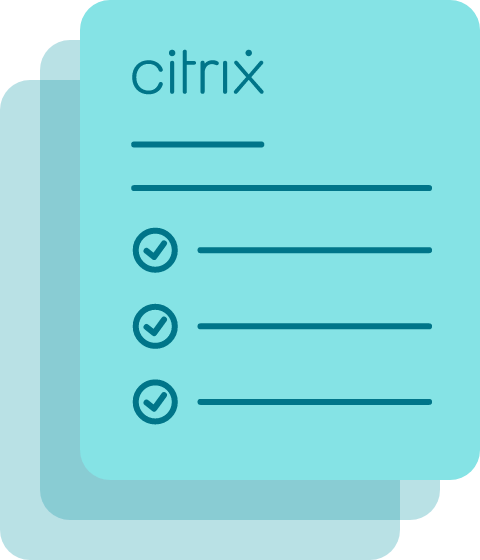Download the Citrix Workspace App
Citrix Workspace app is the easy-to-install client software that provides seamless secure access to everything you need to get work done.
In simple terms, cloud computing is a range of services delivered over the internet, or “the cloud.” It means using remote servers to store and access data instead of relying on local hard drives and private datacenters.
Before cloud computing existed, organizations had to purchase and maintain their own servers to meet business needs. This required buying enough server space to reduce the risk of downtime and outages, and to accommodate peak traffic volume. As a result, large amounts of server space went unused for much of the time. Today’s cloud service providers allow companies to reduce the need for onsite servers, maintenance personnel, and other costly IT resources.
Explore additional cloud computing topics:
There are three types of cloud computing deployment models: private cloud, public cloud, and hybrid cloud.
Private cloud provides a proprietary cloud environment dedicated to a single business entity, with physical components stored on-premises or at a vendor’s datacenter. Because the private cloud is only accessible to a single business, this model offers a high degree of control. Advantages include customized architecture, advanced security protocols, and the ability to extend computing resources in a virtualized environment as needed. In many cases, an organization maintains a private cloud infrastructure on-site while delivering cloud computing services to internal users via the intranet. In other instances, the organization contracts with a third-party cloud vendor to host and maintain exclusive servers off site.
Public cloud uses the internet to store and manage access to data and applications. It’s completely virtualized, providing an environment where shared resources are leveraged as needed. Because these resources are delivered over the web, the public cloud deployment model allows organizations to scale more easily—the ability to pay for cloud resources as needed is a huge advantage over local servers. In addition, public cloud service providers offer robust security measures to protect user data from being accessed by other tenants.
Hybrid cloud combines private and public cloud models, allowing organizations to leverage the benefits of shared resources while using existing IT infrastructure for critical security requirements. The hybrid cloud model allows companies to store confidential data internally and access it via applications running in the public cloud. To comply with privacy regulations, for example, an organization could store sensitive user data in a private cloud and perform resource-intensive computation in the public cloud.
In addition, businesses can choose to take a multi-cloud approach, which means they use more than one public cloud service. This approach can be used to distribute workloads across multiple cloud platforms, allowing organizations to optimize their environments for performance, flexibility, and cost savings.
Cloud computing has gained popularity at a rapid pace because it offers a number of benefits. It’s more cost-effective than on-site server installations and can provide faster service than a traditional installation.
In addition, cloud computing models are easy to scale. The cloud extends alongside an organization's fluctuating needs, making it easy to accommodate real-time changes in computing power needs. The cloud is also very reliable, offering dependable data backup for disaster recovery and business continuity. Businesses that leverage cloud environments do not need to maintain complex hardware, nor do they need to build solutions from scratch. The cloud allows teams to get projects up and running as soon as they receive executive sign off.
GUIDE
See how Citrix DaaS can help you make the most of today’s cloud computing capabilities.
While cloud computing can take many forms, the majority falls into three key areas. Each type of cloud computing provides its own set of advantages.
Traditionally, software was installed directly on each individual device. With the software as a service (SaaS) computing model, web applications are hosted in the cloud to reduce costs through pay-as-you-go pricing. End users can easily connect to the cloud application through a web browser or mobile device, and there’s no need for IT departments to get involved with management or maintenance. Examples include Gmail and Salesforce CRM, as well as cloud storage services like OneDrive and Dropbox.
The infrastructure as a service (IaaS) computing model moves an organization's entire datacenter to the cloud. The business rents virtual machines (VMs), virtual servers, operating systems, and other IT infrastructure on a pay-as-you-go basis. The cloud service provider is responsible for maintaining all data storage servers and networking hardware, eliminating the need for a resource-intensive, on-site installation. Examples include Microsoft Azure, Google Cloud, and Amazon Web Services (AWS).
The platform as a service computing model gives organizations the power to develop software without needing to maintain the backend environment. PaaS vendors optimize environments for each tenant's unique needs, and often include supplemental development tools such as storage resources, compile services, and version control.
Cloud providers take cloud security very seriously. Vendors have developed complex security protocols based on encryption and authentication, and take steps to ensure tenants can’t access their neighbor's data.
In general, servers are regulated by the laws of the country they reside in. That means data stored on a European server will be regulated differently than a server in the U.S. Organizations that handle private user data need to be aware of all regulations that may apply to their cloud solutions.
Cloud computing has gained popularity at a rapid pace because it offers a number of benefits. It’s more cost-effective than on-site server installations and can provide faster service than a traditional installation.
In addition, cloud computing models are easy to scale. The cloud extends alongside an organization's fluctuating needs, making it easy to accommodate real-time changes in computing power needs. The cloud is also very reliable, offering dependable data backup for disaster recovery and business continuity. Businesses that leverage cloud environments do not need to maintain complex hardware, nor do they need to build solutions from scratch. The cloud allows teams to get projects up and running as soon as they receive executive sign off.
